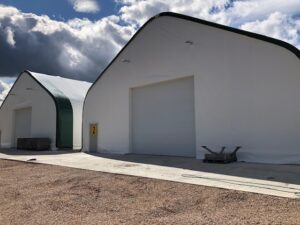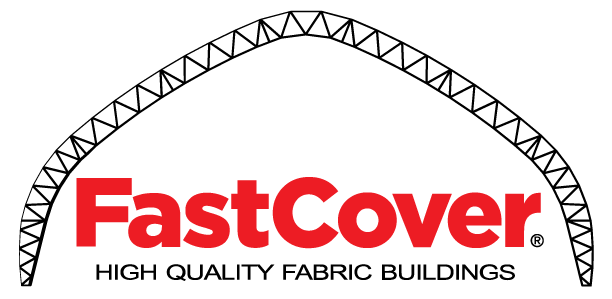If you’re contemplating investing in a coverall building or fabric structure, you’re likely wondering about the associated costs and the advantages over traditional construction. At FastCover, we’re leaders in fabric structure production, and we want to share some valuable insights into the true value of these coverall buildings. Let’s delve deeper into what makes these buildings cost-effective and efficient.
Factors Affecting the Cost of a Coverall Fabric Structure
Compared to traditional wood, steel or concrete buildings, coverall fabric buildings are almost always significantly less expensive – both in terms of upfront building costs and maintenance costs over time. These are the factors that influence the initial investment and costs over time.
- Size of the fabric structure
- Labour and installation costs
- Location of the coverall building
- Utility and maintenance costs
 How Size Influences Cost
How Size Influences Cost
The size of your coverall building directly influences the cost. Naturally, the larger the size, the more materials are needed. Compared to wood buildings, however, a steel structure’s longevity and durability, combined with lower maintenance costs, make them a preferable and more affordable option over time. Wood structures are prone to issues such as rot, pests, and weather damage, whereas steel frameworks are more resilient.
Wooden buildings, by their nature, are heavier than fabric buildings. As a wooden building’s size increases, the costs rise not just linearly (by square footage) but potentially exponentially due to the need for enhanced structural support (more trusses or more substantial trusses), larger foundation footings, and more complex engineering considerations.
Typically, for residential or small-scale wooden buildings, standard trusses can span up to 30 to 35 feet without needing specialized designs or reinforcements. When wooden structures exceed spans of around 30 to 35 feet, and especially when they surpass 40 feet, the construction requirements—and thereby costs—escalate significantly. It’s in these medium to large spans where fabric buildings often present more pronounced cost advantages due to their simpler design and lighter weight.
Wooden structures generally require more substantial foundations than fabric structures due to their weight. The larger the building, the more profound and stronger the foundation typically needs to be.
In contrast, some coverall buildings, especially those on the smaller side, can be anchored with stakes or weighted down, avoiding the need for a traditional foundation. However, as fabric buildings grow in size or are designed for more permanent applications, they too require more substantial foundations.
Labour Efficiency
The amount of labour required for a coverall fabric building is less than that of traditional structures. The simplicity of fabric structures means quicker installation. Steel frames, the backbone of these structures, can be set up in hours to days based on the design’s complexity. Covering these frames with fabric, whether as one large piece or in sections, requires fewer man-hours and can cut your installation time in half compared to conventional building installs.
 Location of the Coverall Building
Location of the Coverall Building
The site of your coverall building can impact costs. For areas with uneven terrain, such as mining sites or oil fields, groundwork levelling will be necessary. Should you be using your canvas structure for storage, a concrete foundation might also be essential.
Utility and Maintenance Expenses
Planning for long-term costs is crucial. Coverall fabric buildings, devoid of screws or nails on their roofs, are less susceptible to issues like leaks or rust. Their fabric protects against UV rays, safeguarding the contents inside. Additionally, with a translucency rate of 16-19%, these buildings offer abundant natural light, diminishing the need for artificial lighting and subsequently lowering utility costs. At night, minimal lighting is necessary due to the fabric roof’s reflective properties. Being non-conductive, fabric sheds are adept at maintaining internal temperatures, necessitating less heating or cooling. Insulation options are still available if required. Our canvas structures come with a 15 year prorated warranty that covers defects in workmanship and materials.
The Overarching Benefits of Coverall Canvas Buildings
Fabric buildings from FastCover come with an array of benefits, both immediate and long-term.
- Efficiency: They can be set up swiftly, making them perfect for projects with tight schedules.
- Economic Value: Not only are coverall buildings generally more affordable upfront, but their reduced maintenance and utility costs also make them a cost-effective choice in the long run.
- Flexibility: These structures are suitable for a plethora of applications, from short-term construction sites to long-term commercial or industrial use.
- Energy Savings: Their design ensures a significant reduction in energy consumption, from lighting to temperature control.
Why Choose FastCover Coverall Buildings?
- All products have a powder coat paint for durability of fabric and steel.
- Engineered stamped drawings are available, assisting with permits and insurance.
- Quality Assurance: Independent third-party engineers review all building models for strength and consistency.
- Portability: FastCover structures have a continuous outer frame, making most sizes easy to move without disassembly.
- 15-year warranty prorated for all steel & fabric.
